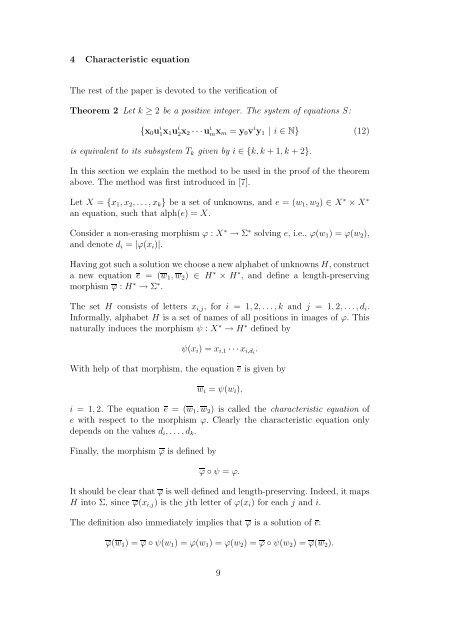On systems of word equations with simple loop sets
On systems of word equations with simple loop sets
On systems of word equations with simple loop sets
Create successful ePaper yourself
Turn your PDF publications into a flip-book with our unique Google optimized e-Paper software.
4 Characteristic equation<br />
The rest <strong>of</strong> the paper is devoted to the verification <strong>of</strong><br />
Theorem 2 Let k ≥ 2 be a positive integer. The system <strong>of</strong> <strong>equations</strong> S:<br />
{x 0 u i 1 x 1u i 2 x 2 · · ·u i m x m = y 0 v i y 1 | i ∈ N} (12)<br />
is equivalent to its subsystem T k given by i ∈ {k, k + 1, k + 2}.<br />
In this section we explain the method to be used in the pro<strong>of</strong> <strong>of</strong> the theorem<br />
above. The method was first introduced in [7].<br />
Let X = {x 1 , x 2 , . . ., x k } be a set <strong>of</strong> unknowns, and e = (w 1 , w 2 ) ∈ X ∗ × X ∗<br />
an equation, such that alph(e) = X.<br />
Consider a non-erasing morphism ϕ : X ∗ → Σ ∗ solving e, i.e., ϕ(w 1 ) = ϕ(w 2 ),<br />
and denote d i = |ϕ(x i )|.<br />
Having got such a solution we choose a new alphabet <strong>of</strong> unknowns H, construct<br />
a new equation e = (w 1 , w 2 ) ∈ H ∗ × H ∗ , and define a length-preserving<br />
morphism ϕ : H ∗ → Σ ∗ .<br />
The set H consists <strong>of</strong> letters x i,j , for i = 1, 2, . . ., k and j = 1, 2, . . ., d i .<br />
Informally, alphabet H is a set <strong>of</strong> names <strong>of</strong> all positions in images <strong>of</strong> ϕ. This<br />
naturally induces the morphism ψ : X ∗ → H ∗ defined by<br />
ψ(x i ) = x i,1 · · ·x i,di .<br />
With help <strong>of</strong> that morphism, the equation e is given by<br />
w i = ψ(w i ),<br />
i = 1, 2. The equation e = (w 1 , w 2 ) is called the characteristic equation <strong>of</strong><br />
e <strong>with</strong> respect to the morphism ϕ. Clearly the characteristic equation only<br />
depends on the values d i , . . .,d k .<br />
Finally, the morphism ϕ is defined by<br />
ϕ ◦ ψ = ϕ.<br />
It should be clear that ϕ is well defined and length-preserving. Indeed, it maps<br />
H into Σ, since ϕ(x i,j ) is the jth letter <strong>of</strong> ϕ(x i ) for each j and i.<br />
The definition also immediately implies that ϕ is a solution <strong>of</strong> e:<br />
ϕ(w 1 ) = ϕ ◦ ψ(w 1 ) = ϕ(w 1 ) = ϕ(w 2 ) = ϕ ◦ ψ(w 2 ) = ϕ(w 2 ).<br />
9
















